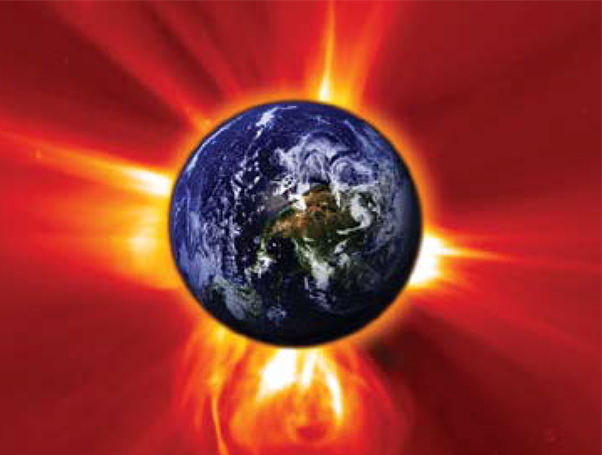
By Roy W. Spencer, Ph.D.
How Warm is the Earth?
You might have heard that "all reputable scientists" agree on global warming—that there is a "consensus," and that the science is "settled." But there is only one aspect of the problem that scientists agree on: that global warming has occurred in the last century. What is not agreed upon is the degree to which mankind is responsible for that warming, and thus how much warming we can expect in the future.
There is little doubt that globally averaged temperatures are relatively warm right now. Warming of about one degree Celsius (close to 2 degrees Fahrenheit) has occurred since the Reports 1800s (Fig. 1). This warming has occurred during the rapid industrialization of the developed world, which has been accompanied by increasing use of fossil fuels (petroleum, coal, and natural gas) that produce carbon dioxide, a greenhouse gas, when burned.
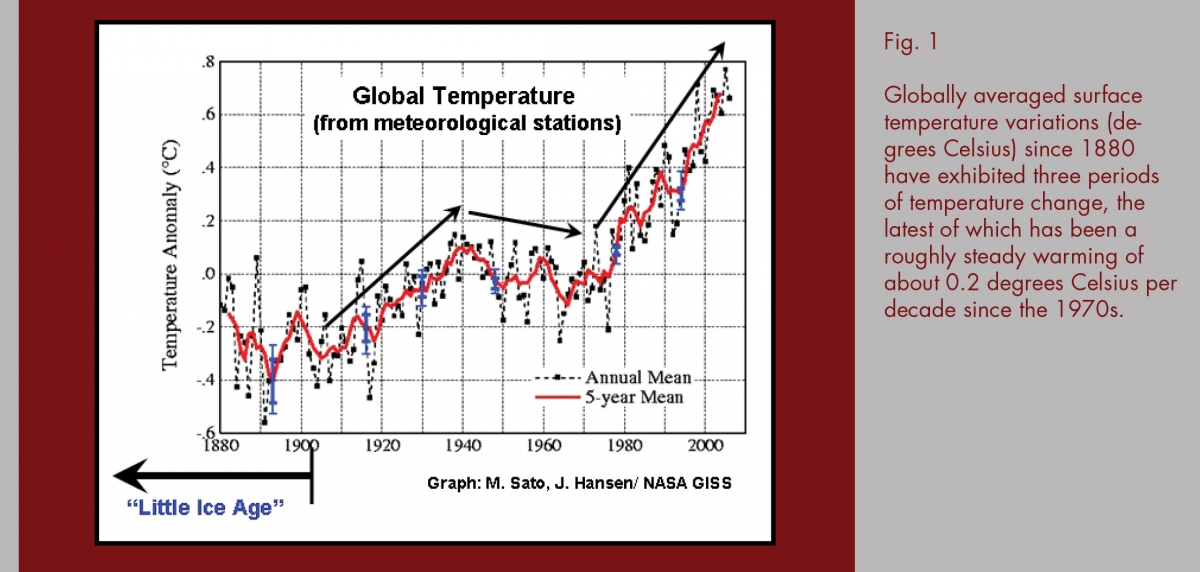
But correlation does not mean causation. For instance, the warming before 1940 could not have been due to manmade greenhouse gases simply because the vast majority of those emissions occurred after 1940. Instead, that warming is more likely the naturally occurring end of the "Little Ice Age," a period of several hundred years of cool conditions. Furthermore, borehole temperatures from the Greenland ice sheet (Fig. 2) suggest that we are still not as warm as about 1,000 years ago, called the "Medieval Warm Period."
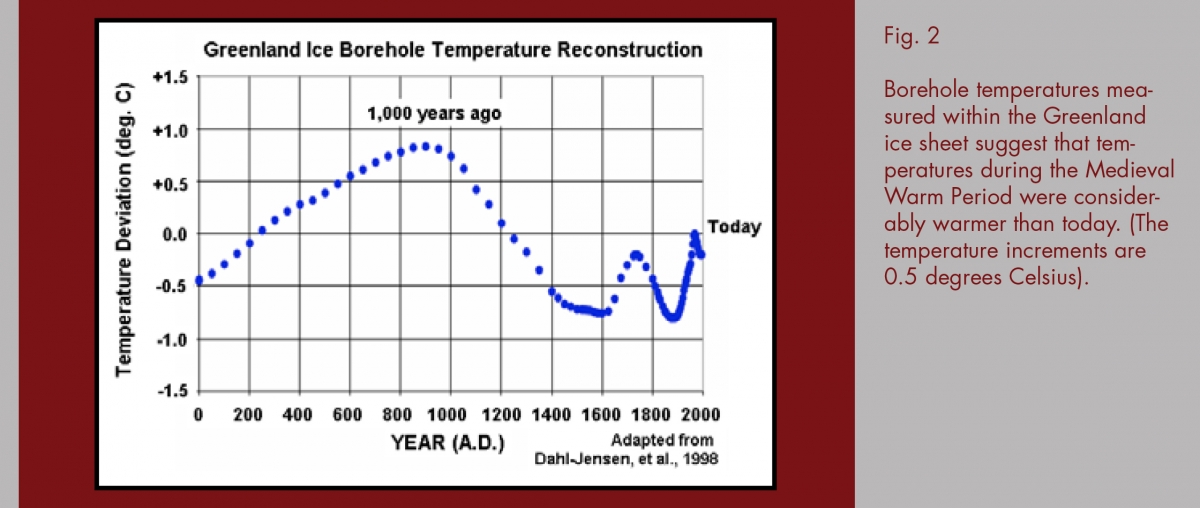
Thus, it is clear that substantial natural climate variations do occur. So, why is it that so many scientists blame our current warmth on mankind's greenhouse gas emissions? Because we do not understand what causes natural climate variations and we can not predict them, so we resort to the only explanation we think we do understand: that carbon dioxide is a greenhouse gas whose concentrations have been steadily increasing (see Fig. 3). And, indeed, it is reasonable to suspect that at least some of our current warmth is due to mankind. But how much? No one knows.

A popular way to "prove" that temperatures are tied to carbon dioxide levels involves ice core measurements from Antarctica, which are claimed to cover hundreds of thousands of years of Earth history (Fig. 4). At face value, this chart suggests a strong relationship between CO2 and temperature.
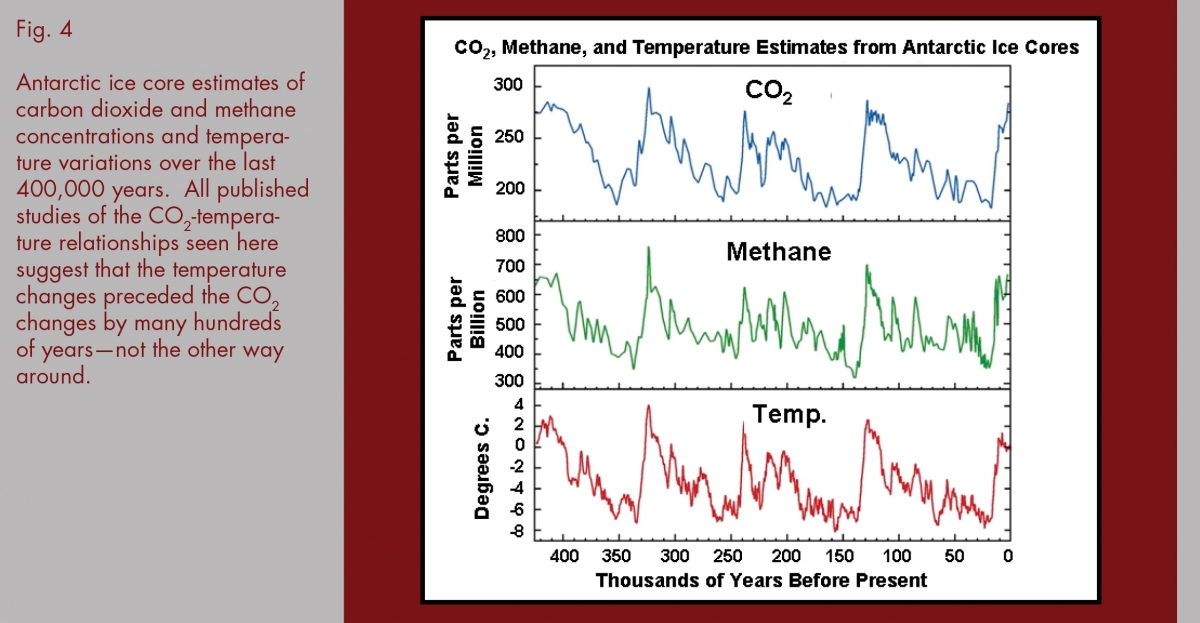
But what is not usually mentioned is the fact that the ice core temperature changes preceded the CO2 changes—by at least 100 years. In other words, the temperature changes caused the CO2 changes, not the other way around as presented in today's global warming theory.
In summary, the belief that our current warmth is due to mankind is just that: a belief. We have no idea how much of the warming is natural, and without that knowledge we cannot know how much is due to mankind. While it is true that all of the warming can theoretically be explained by mankind's activities, this involves some assumptions about the Earth's radiative energy balance and how it is maintained.
Earth's Energy Balance
Global warming theory claims that mankind's greenhouse gas emissions are upsetting the Earth's "energy balance"—which refers to the globally-averaged 235 Watts per square meter (W/m2) of absorbed sunlight being balanced by an equal amount of infrared radiation flowing back to outer space. This energy-in-equals-energy-out condition is assumed to be necessary in order for global temperatures to stay relatively constant.
But our greenhouse gas emissions are now claimed to have upset that balance, with the current imbalance being around one W/m2 (more energy being absorbed than being lost to outer space). This one W/m2 is obviously a tiny fraction of the 235 W/m2 average amount of energy flowing in and out of the Earth's system. By the way, this imbalance is too small to measure from our energy budget instruments flying on Earth-orbiting satellites, so instead it is calculated theoretically.
Earth's "Greenhouse Effect"
Since it is claimed that mankind's greenhouse gas emissions are enhancing the Earth's natural greenhouse effect, we first need to understand how that greenhouse effect is maintained. A greenhouse gas traps infrared (heat) radiation within the atmosphere, warming the lower atmosphere and cooling the upper atmosphere. It can be thought of as a "radiative blanket" that traps heat in the lower atmosphere. But what many people don't realize is that the Earth's natural greenhouse effect is mostly due to water vapor and clouds—trace gases like carbon dioxide and methane are relatively minor contributors. This means that the greenhouse effect is largely under the control of the weather, primarily precipitation systems (Fig. 5).
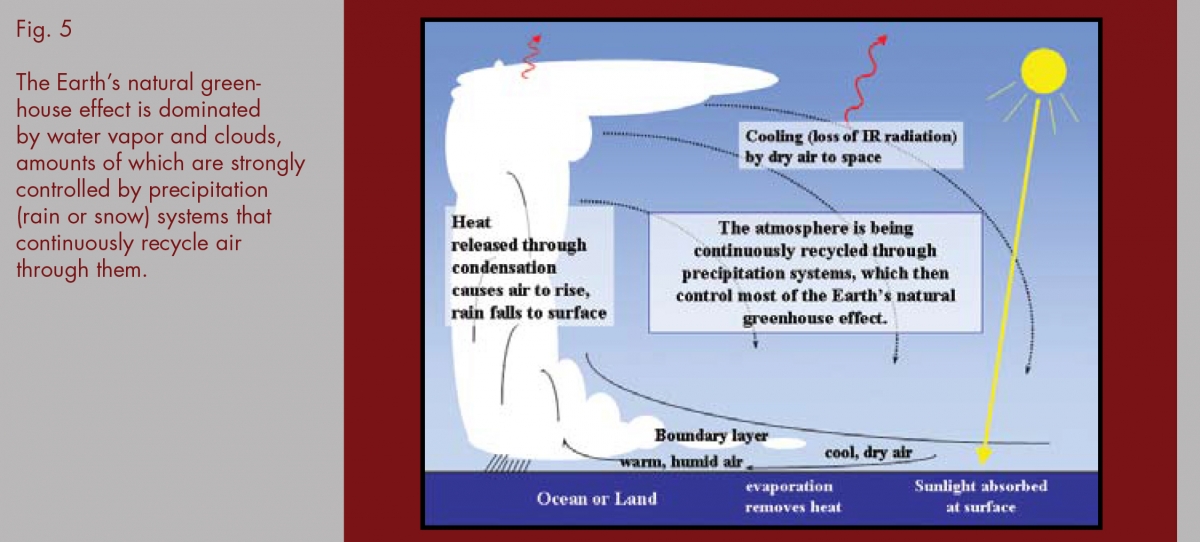
In Fig. 5 we see that air is being continuously recycled through precipitation (rain or snow) systems, which gather up the near-surface air that has been humidified by evaporation. That water vapor eventually forms clouds, some of which produce rain or snow that then returns the water back to the surface. For all of that air being drawn into the lower part of those precipitation systems, an equal amount of air must also be flowing out their tops. This air, which has water vapor and cloud amounts determined by precipitation processes, then gradually spreads over most of the Earth, slowly sinking and filling the troposphere and determining the bulk of the atmosphere's natural greenhouse effect.
So, since precipitation systems have a controlling influence on the Earth's natural greenhouse effect, it is imperative that we understand how these systems might change with warming. After all, mankind's estimated 1 percent enhancement of the natural greenhouse effect is small compared to the kinds of changes that weather systems cause on a daily basis. So, if nature has so much control over the greenhouse effect, with the inherent ability to cause cooling or warming, why do we see such a stable globally-averaged temperature, year after year? I believe it is because these weather systems act as a natural thermostat, adjusting precipitation, cloud, and water vapor amounts in response to solar heating in such a way that a stable average temperature is maintained.
Climate Models
Since it is the climate models that we rely upon for forecasts of global warming, it is essential that those climate models handle precipitation processes in a realistic way. Climate models are complex computer programs that describe the basic behavior of the atmosphere and its interaction with the Earth's surface with mathematical equations. Equations governing winds, temperature, water vapor, clouds, precipitation, and solar and infrared radiation amounts are run on supercomputers to see what happens when the infrared effects of extra carbon dioxide are added to the model. The models are usually run for 100 years or more of simulated time, and they "grow" weather systems all over the computer-simulated Earth.
It turns out that the direct warming effect of more carbon dioxide is relatively small. It has been estimated that at CO2 doubling, which could occur late in this century, there would be only 1 degree Fahrenheit of surface warming. But almost all of the dozen or so models that are used for climate forecasting suggest that the warming from the extra carbon dioxide will be amplified by changes in the atmosphere. This amplification is called "positive feedback," and it is the reason why you sometimes hear predictions of catastrophic levels of warming. If any processes act as a natural thermostat, reducing the small warming influence of the extra CO2, they would be called "negative feedbacks."
Feedbacks are at the heart of most scientific debate over how much warming we can expect in the future. The two largest positive feedbacks exhibited by climate models are due to water vapor and clouds, which (as has already been noted) are also the primary ingredients of the Earth's natural greenhouse effect.
Water Vapor Feedback
Most, if not all, climate modelers say that water vapor (the Earth's dominant greenhouse gas) will increase with the CO2-induced warming tendency, causing a positive feedback. This is usually explained by noting that a warmer surface causes the evaporation of more water.
But the surface evaporation rate is not what determines the average amount of water vapor that resides in the atmosphere—precipitation systems do. For a given amount of available sunlight, solar heating of the surface causes the atmosphere to generate a surface temperature-driven greenhouse effect (water vapor and cloud amounts) consistent with the amount of absorbed solar energy.
Even though the climate cheap jerseys models include the average effects of precipitation, I believe that they do not behave realistically in the way that precipitation processes change with warming. Warmer precipitation systems are believed to be more efficient at removing water vapor than cooler precipitation systems. Unfortunately, precipitation processes are exceedingly complex, and so climate model representations of them are necessarily very crude.
Cloud Feedbacks
While most climate modelers think that water vapor feedback is a solved problem, everyone agrees that feedback due to clouds is still quite uncertain. Increasing amounts of high (cirrus) clouds with warming would cause a positive cloud feedback. This is because the infrared trapping (greenhouse warming) effect of high clouds is greater than their sunlight reflection (cooling) effect. Conversely, an increase in low cloud coverage with warming causes just the opposite effect, with net cooling and thus a negative feedback.
All of today's climate models exhibit net positive cloud feedbacks with warming, but by widely varying strengths. There is a critical need to use our satellite data resources to try to test whether the climate models are behaving in ways that are consistent with the real climate system.
How Much Warming Can We Expect?
All climate models exhibit various levels of positive feedback, amplifying the small, one degree Fahrenheit of direct warming from a doubling of carbon dioxide to anywhere from four to ten degrees by the end of this century. But how much global warming you believe will occur in the future depends entirely upon how much faith you have that the climate models contain all of the important processes that determine how sensitive the climate is to increasing greenhouse gas concentrations.
I believe that the models do not correctly handle precipitation processes, and it is those processes which control most of the Earth's wholesale NFL jerseys natural greenhouse effect. I think that these systems act as nature's thermostat (negative feedback mechanism) that maintains a relatively constant temperature for a given amount of absorbed sunlight.
So, if there is such a temperature control mechanism in the climate system, what could explain our current warmth? One theory is that it is related to variations in the sun, which is more active now than it has been for many centuries. Even though this increased solar activity has increased the total solar energy reaching the Earth by only a tiny amount, there could be more subtle processes at work. One theory is that solar-influenced changes in cosmic rays reaching the Earth exert some level of control over low level cloudiness. Also, the climate system is so complex that there might well be processes at work that we currently are not even aware of.
Policy Options
But if there is any chance that global warming Die will be serious, shouldn't we "do something" about it? Yes—if what we do actually fixes the problem, and does not hurt humanity more than it helps.
If there is only one single message I could get out to the public on the global warming issue, it would be this:
Even if future global warming turns out to be a serious problem, there is very little we can do without the development of new energy technologies.
Every currently proposed policy "solution" to the global warming problem will have little effect on future levels of warming. Conservation approaches such as buying compact fluorescent bulbs and hybrid cars might make us feel better about ourselves, but those things will have an unmeasurable effect on future warming.
Similarly, the internationally-negotiated Kyoto Protocol for reducing greenhouse gas emissions (which the United States has not adopted) is known to be only a first baby step toward substantial reductions in greenhouse gas emissions. Current U. S. congressional alternatives to Kyoto are even weaker.
The truth is that humanity's need for energy is simply too great for any of the currently proposed solutions to make much of a difference. Solar and wind power sources will no doubt grow rapidly, but they will still provide only a small fraction of our energy needs. Biofuels will also be a relatively small player: even if all the corn grown in the U.S. was used to make alcohol, this would only satisfy 12 percent of our transportation fuel needs.
Using nuclear power plants rather than coal-fired ones could help, but it takes many years for their construction and they remain politically unpopular. Hydrogen-powered transportation is still not ready for primetime, and even if it were, a Flooding non-polluting energy source will be needed to generate the hydrogen—such as nuclear power. Likewise, electric cars still need an energy source, which today means mostly coal-fired power plants.
One possible new technology is called "clean coal," where the carbon dioxide generated during the burning of the coal is sequestered (stored) deep in the ground. Today, this technology is still rather expensive, approximately doubling the price of electricity.
There are still over one billion people in the world who do not have access to electricity. Their lives are difficult—and short. None of us would want to live under the conditions these people live under. But as India and China continue to grow in prosperity, their poverty will be alleviated. And history has shown that the more prosperous the country, the lower its birth rate. Thus, population growth is expected to slow substantially in the coming decades as more countries build themselves up economically.
But this prosperity requires access to abundant sources of energy—and fossil fuels will dominate the world's energy mix for decades to come. Since it is only the affluent countries of the world that can afford the research to develop the new energy technologies that all of humanity needs, it is critical that economic progress be encouraged—not stifled.
Unfortunately, all currently proposed approaches to attacking global warming will punish —É–ø—Ä–∞–≤–ª–µ–Ω–∏–µ economic growth, and for very little environmental gain. It is imperative that we all become better informed on global warming issues, both the cheap jerseys science and the policy. The energy problem is too important to be wasting time and money on "solutions" that will have very little effect. It is only through smart, informed decisions that we will make the world a better place for our children and grandchildren.
About the Author: Dr. Roy W. Spencer is a principal research scientist for the University of Alabama in Huntsville and the U.S. Science Team Leader for the Advanced Microwave Scanning Radiometer (AMSR-E) on NASA’s Aqua satellite. In the past, he has served as Senior Scientist for Climate Studies at NASA’s Marshall Space Flight Center in Huntsville, AL. Dr. Spencer is the recipient of NASA’s Medal for Exceptional Scientific Achievement and the American Meteorological Society’s Special Award for his satellite-based temperature monitoring work. He is the author of numerous scientific articles. Dr. Spencer received his Ph.D. in Meteorology from the University of Wisconsin in 1981.

